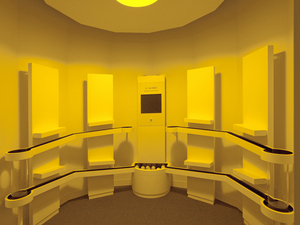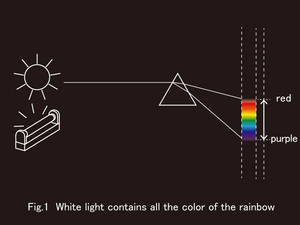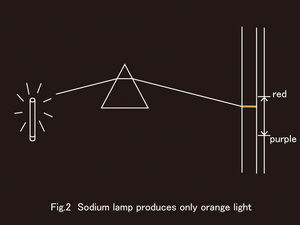Nagoya City Science Museum
TOP > Exhibition Guide > Keyword Search > Starting with "S" > sodium lamp > Wonder of Orange Light
Wonder of Orange Light



Purpose of Exhibition
The exhibition demonstrates the phenomenon that involves red, green and blue balls appearing to be all the same color.
With this exhibition, one can understand what is color and what is light.
Additional Knowledge
In the exhibit, most of the balls can be seen as the same color.
One cannot distinguish the different shades of color.
This is caused by the light hitting the balls. The orange light hitting the balls is generated by lighting equipment called a sodium lamp.
The light of that sodium lamp is very special: the components of the light color are completely different from other light sources.
You can observe through a prism the sun-light and fluorescent light and see the seven colors of the rainbow.
The light of the sun and fluorescent light may appear to have no color, but it is actually a mixture of seven colors: red, orange, yellow, green blue, indigo and violet.
Even by observing the light divided by a prism, you cannot clearly see seven colors.
The seven colors continuously change in turn.
According to the way you look, you can see six colors, but you can also feel as though there are more colors. Sodium lamps have orange light, and even through a prism, other colors do not appear.
As for often seen red or green lamps, if observed through a prism, not only can you see red and green, but many other colors can also be observed.
However, in the case of the sodium lamplight, it's an orange light with no other colors mixed.
Objects illuminated by such light cannot be illuminated by colors other than orange.
Unless the object emits light by itself, it only reflects the light it was illuminated by.
Sodium lamps only reflect the color orange; even if the balls are red or green, those balls can only be seen orange.
The reason why you cannot identify the color of the balls is because of the sodium lamp. However, according to whether there are a few reflections or many reflections, there is a difference of shade.
It is possible to distinguish between colors within the red light created by a filter and not a sodium lamp, because within the red light there is some green and yellow light. The most common use of sodium lamps in everyday life is in tunnel and road lighting. By using an orange-only color called a monochromatic light, the visibility in gas and dust improves, and things can be seen clearly. As for another advantage, insects aren't attracted to the light because no ultraviolet is emitted. There are mainly two types of sodium lamps: low pressure sodium lamps and high pressure sodium lamps.
A low pressure sodium lamp is used in this exhibit.
As you can understand from the exhibit, this lamp can hardly distinguish any colors.
Therefore, it is difficult to use a high pressure sodium lamp, because it is better at distinguishing colors when used in greater numbers.
The difference between low pressure and high pressure lamps is that the pressure of the sodium vapor within the lamp is high in one case and low in the other.
Non-orange colors can appear depending on the high pressurization of the sodium vapor. The sun and fluorescent lighting has no color, but those kinds of lights are called white light.
When examining the sun-light, the green color component was strongly separated from the left and right (red and purple) of the spectrum, and the light density decreased.
Because earth's creatures have evolved under the sun, with the sun-light as basis, this light is called white light by humans.
Article by Yoshitaka Yamada, curator
